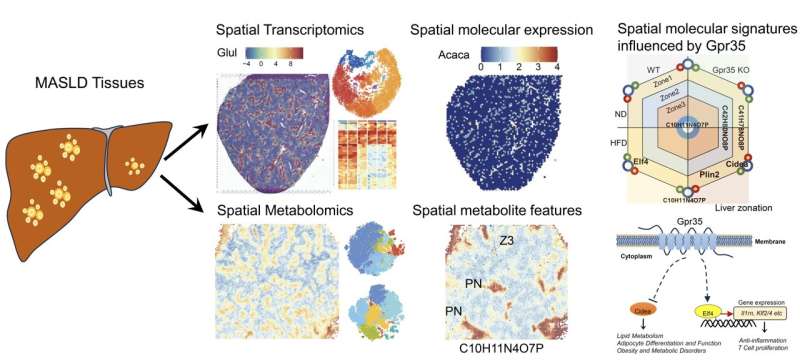This article has been reviewed according to Science X's editorial process and policies. Editors have highlighted the following attributes while ensuring the content's credibility:
fact-checked
proofread
Researchers use spatial multi-omics to investigate liver zonation and role of GPR35 in disease regulation

Metabolic dysfunction-associated steatotic liver disease (MASLD), an escalating metabolic disorder, poses a severe challenge to global health. However, our understanding of its underlying molecular mechanisms remains limited.
The lobular zonation of the liver is a tissue characteristic that classifies the liver into Zone 1, Zone 2, and Zone 3 from the portal vein to the central vein, with distinct gene expression profiles across these zones. The disruption of this zonation is related to the development of MASLD, yet it has not been fully explored.
The application of cutting-edge technologies such as single-cell RNA sequencing, spatial transcriptomics, and spatial metabolomics holds promise in elucidating the role of liver zonation in disease, providing new strategies and targets for the prevention and treatment of MASLD.
GPR35, an orphan G protein-coupled receptor, plays a role in regulating lipid metabolism, thermogenesis, and inflammatory responses in adipose tissue, maintaining energy homeostasis.
Although GPR35 has been considered as a potential therapeutical target for MASLD, its exact role in fatty liver progression and how it regulates metabolism in specific liver regions requires further investigation.
On May 31, 2024, a research team, led by Professor Hai-long Piao from the Dalian Institute of Chemical Physics, Chinese Academy of Sciences, published an article titled "Spatial multi-omics characterize GPR35-relevant lipid metabolism signatures across liver zonation in MAFLD" in Life Metabolism. In this study, the researchers employed spatial metabolomics and spatial transcriptomics to delve into the zonation characteristics of the liver and to clarify the role of GPR35 in regulating fatty liver disease.
Preliminarily, the researchers found that under high-fat diet (HFD) conditions, GPR35 indeed differentially regulated numerous metabolites and genes across different liver regions. Subsequently, by employing spatial transcriptomics and spatial metabolomics techniques, the researchers successfully identified key genes and metabolites in the MASLD progression.
In spatial transcriptomics analysis, the researchers found that GPR35 could regulate lipid accumulation, inflammatory responses, and metabolic processes in different liver regions, particularly the significant regulation of the anti-inflammatory factor ELF4 (E74 like E-twenty six (ETS) transcription factor 4) in liver Zone 2; the key factor for lipid homeostasis, CIDEA (cell death-inducing DNA fragmentation factor alpha (DFFA)-like effector A), in Zone 1; and genes related to injury response, SAA1/2/3 (the injury response-related genes serum amyloid A1/2/3), which showed significant changes in specific liver regions.
Additionally, in spatial metabolomics analysis, the researchers discovered the distribution of 3',5'-cyclic inositol monophosphate (3',5'-cyclic IMP) in the central vein area, which was significantly reduced in the liver regions of Gpr35 KO mice.
The findings of this study not only clarify the role of GPR35 in liver zonation and MASLD but also reveal new genes and metabolites that may be related to the function of GPR35, providing a new perspective for further research on the function of GPR35 in regulating lipid metabolism, which is of great significance.
These discoveries also have guiding significance for the development of new therapies for MASLD and are expected to provide new strategies for the treatment and management of fatty liver disease.
More information: Wuxiyar Otkur et al, Spatial multi-omics characterizes GPR35-relevant lipid metabolism signatures across liver zonation in MASLD, Life Metabolism (2024). DOI: 10.1093/lifemeta/loae021



















